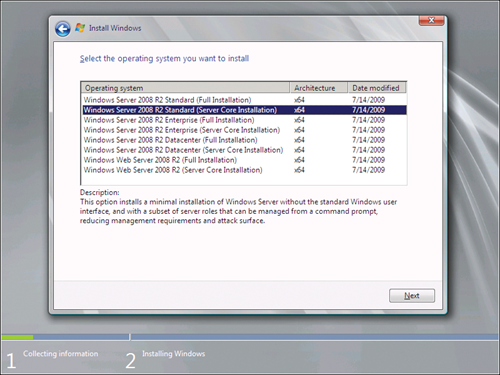Security is an important consideration when deploying servers with
the Active Directory Domain Services (AD DS) role installed. Many
organizations store sensitive data within the directory, such as
personal information and user passwords, which must be protected
accordingly. Although the role-based configuration of Windows Server
2008 R2 reduces the attack surface of a server by installing only the
components and services required by its roles, it is possible to further
reduce the attack surface of the server by installing Windows Server
2008 R2 with the Server Core installation option. A Server Core installation is a minimal installation of Windows Server
that installs only the most critical core operating system components
required to run Windows Server 2008 R2. Most Windows graphical user
interface (GUI) elements are not installed as part of a Server Core
installation, limiting the ability of malicious users to gain access to
the server using the familiar Windows Explorer interface.
A Server Core installation can be administered from another server
using remote GUI tools such as Server Manager for most common tasks.
However, to manage a Server Core installation locally, you must be
familiar with the command-line tools necessary to administer a Windows
Server 2008 R2 server and its installed roles. In this lesson, you learn
more about the Server Core installation option. You also learn how to
configure a domain controller from the command line within a Server Core
installation and how to remove domain controllers from a domain.
1. Understanding Server Core
A Windows Server 2008 R2 Server Core installation is a minimal
installation of Windows that consumes about 3 GB of disk space and
less than 256 MB of memory. A Server Core installation limits the
server roles and features that can be added but can improve the
security and manageability of the server by reducing its attack
surface. The number of services and components running at any one time
are limited, so there are fewer opportunities for a user with
malicious intent to compromise the security of the server. Because of
the decreased roles and features installed, a Server Core installation
also reduces the administrative burden of the server, which requires
fewer updates and less maintenance.
Server Core supports the following server roles:
Active Directory Certificate Services
Active Directory Domain Services
Active Directory Lightweight Directory Services (AD
LDS)
BranchCache Hosted Cache
DNS Server
Dynamic Host Configuration Protocol (DHCP) Server
File Services
Hyper-V
Print and Media Services
Streaming Media Services
Web Server (IIS) (including a subset of ASP.NET)
Server core also supports these optional
features:
Failover Clustering
Multipath I/O
Network Load Balancing
Quality of Service (QoS)
Removable Storage Management
Simple Network Management Protocol (SNMP)
Subsystem for UNIX-based applications
Telnet client
Windows Bitlocker Drive Encryption
Windows Internet Name Service (WINS)
Windows-on-Windows 64-bit (WoW64)
Windows PowerShell
Windows Server Backup
2. Installing Server Core
You can install Server Core by using the same steps presented in
Exercise 1 of Lesson 1. The following points outline the key
differences between a full installation of Windows Server 2008 R2 and a Server Core
installation:
You must select the Server Core installation option when
running the Windows Server 2008 R2 installation wizard, as shown
in Figure 1.
At the conclusion of the installation process, you are
presented with a command prompt window, rather than the full
Windows Server 2008 R2 GUI.

1.3.3. Performing Initial Configuration Tasks
On a server running a full installation of Windows Server
2008 R2, the Initial Configuration Tasks window guides you through
post-installation configuration of the server. A Server Core installation provides no GUI, so you must
complete the tasks by using command-line tools. Table 1 lists common
configuration tasks and the commands you can use. To learn more about
any command, open a command prompt and type the name of the command
followed by /?.
Table 1. Server Core Configuration Commands
| TASK | COMMAND |
|---|
| Change the Administrator password | Net user administrator
* |
| Set a static IPv4 configuration | Netsh interface
ipv4 |
| Activate Windows Server | Cscript c:\windows\system32\slmgr.vbs
-ato |
| Join a domain | Netdom |
| Install optional components (roles, role services, or features) | Ocsetup.exe <package or
feature> Note that the package or feature
names are case sensitive. List the valid packages and features
by entering the command Ocsetup
/?. |
| Display installed roles, components, and
features | Oclist.exe |
| Enable Remote Desktop | Cscript
c:\windows\system32\scregedit.wsf /AR
0 |
| Promote a domain controller | Dcpromo.exe |
| Configure DNS | Dnscmd.exe |
| Configure DFS | Dfscmd.exe |
The Ocsetup.exe command adds supported
Server Core roles and features to the server. The exception to this rule is AD DS. Do not use
Ocsetup.exe to add or remove AD DS. Use
Dcpromo.exe instead.